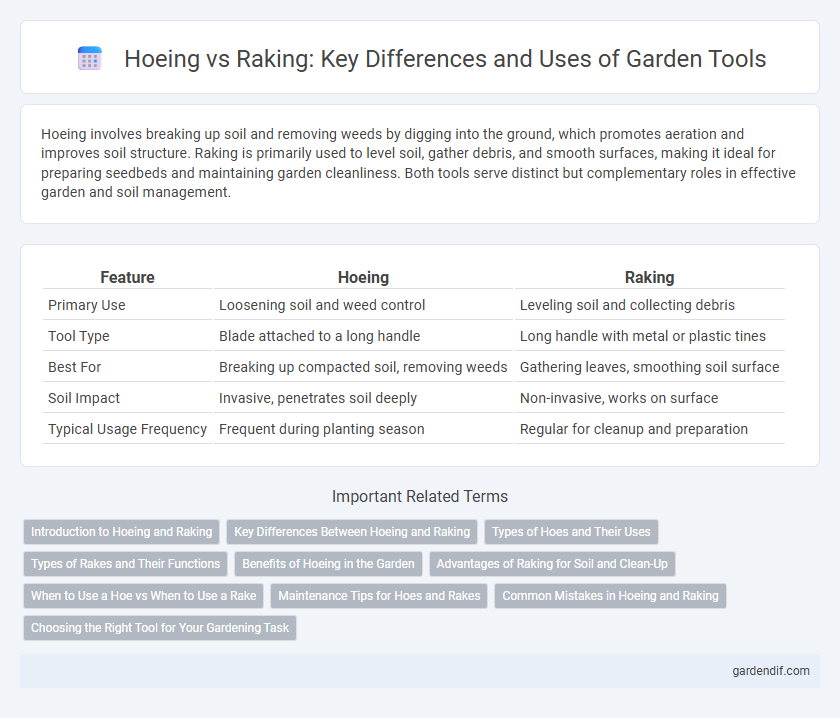
Hoeing vs Raking Illustration
Hoeing involves breaking up soil and removing weeds by digging into the ground, which promotes aeration and improves soil structure. Raking is primarily used to level soil, gather debris, and smooth surfaces, making it ideal for preparing seedbeds and maintaining garden cleanliness. Both tools serve distinct but complementary roles in effective garden and soil management.
Table of Comparison
| Feature | Hoeing | Raking |
|---|---|---|
| Primary Use | Loosening soil and weed control | Leveling soil and collecting debris |
| Tool Type | Blade attached to a long handle | Long handle with metal or plastic tines |
| Best For | Breaking up compacted soil, removing weeds | Gathering leaves, smoothing soil surface |
| Soil Impact | Invasive, penetrates soil deeply | Non-invasive, works on surface |
| Typical Usage Frequency | Frequent during planting season | Regular for cleanup and preparation |
Introduction to Hoeing and Raking
Hoeing and raking are essential gardening tools designed to maintain soil health and garden cleanliness. A hoe features a flat blade attached perpendicular to a long handle, ideal for breaking up soil, removing weeds, and creating planting rows. In contrast, a rake consists of a long handle with tines or teeth used for gathering leaves, debris, and leveling soil surfaces.
Key Differences Between Hoeing and Raking
Hoeing involves using a hoe to break up soil, remove weeds, and create planting rows, primarily targeting soil aeration and weed control at the root level. Raking employs a rake to gather leaves, debris, and smooth soil surfaces, emphasizing surface-level garden maintenance and soil leveling. The key difference lies in hoeing's focus on soil cultivation and weed removal beneath the surface, while raking targets surface debris management and soil texture refinement.
Types of Hoes and Their Uses
Types of hoes include the draw hoe, scuffle hoe, and stirrup hoe, each designed for specific gardening tasks such as breaking soil, weeding, and cultivating. The draw hoe features a flat blade ideal for chopping and shaping soil, while the scuffle hoe has a looped blade effective in cutting weeds just below the soil surface. The stirrup hoe uses a sharp, oscillating blade to slice through weeds efficiently, making it suitable for maintaining garden beds and pathways.
Types of Rakes and Their Functions
Garden rakes include leaf rakes, designed with flexible tines to collect leaves and lightweight debris, and bow rakes, which feature rigid, short tines ideal for leveling soil and breaking up clumps. Landscape rakes are specialized for larger debris and gravel, while thatch rakes are used to remove dead grass and organic matter from lawns. Selecting the appropriate rake type enhances garden maintenance efficiency and soil health.
Benefits of Hoeing in the Garden
Hoeing improves soil aeration by breaking up compacted earth, which enhances root growth and water absorption. It effectively controls weeds by cutting them off at the root, reducing competition for nutrients in the garden. Regular hoeing also promotes better soil moisture retention, leading to healthier plants and increased crop yields.
Advantages of Raking for Soil and Clean-Up
Raking enhances soil aeration and promotes efficient removal of dead leaves and debris, preventing mold and pest infestations. It creates a fine, level surface ideal for planting and seed germination, improving overall soil health. The versatility of rakes allows for effective clean-up in various garden terrains, making soil management more precise and less labor-intensive.
When to Use a Hoe vs When to Use a Rake
Use a hoe for breaking up soil, removing weeds, and cultivating garden beds, especially in tight or densely planted areas where precision is needed. Rakes are ideal for leveling soil, clearing leaves, spreading mulch, and smoothing garden surfaces over larger, open areas. Select a hoe when you need targeted soil aeration and weed control, and choose a rake for surface finishing and debris cleanup tasks.
Maintenance Tips for Hoes and Rakes
Maintaining hoes and rakes involves regular cleaning to prevent rust and prolong tool life, using warm soapy water and thorough drying after each use. Sharpening hoe blades with a file ensures efficient soil penetration, while straightening and tightening rake tines maintains optimal performance. Storing tools in a dry, sheltered area and applying a light coat of oil to metal parts prevents corrosion and preserves the durability of gardening tools.
Common Mistakes in Hoeing and Raking
Common mistakes in hoeing include using a hoe with the wrong blade angle, which can damage soil structure and harm plant roots. In raking, typical errors involve applying excessive pressure, leading to soil compaction and ineffective debris removal. Both tools require proper technique to maintain soil health and optimize garden productivity.
Choosing the Right Tool for Your Gardening Task
Hoeing effectively breaks up soil and removes weeds with minimal disturbance, making it ideal for preparing garden beds and controlling stubborn weeds. Raking excels at leveling soil, clearing debris, and spreading mulch, providing a smooth surface and promoting even soil aeration. Selecting the right tool depends on whether your goal is soil cultivation or surface maintenance to optimize garden health and growth.
Hoeing vs Raking Infographic

 gardendif.com
gardendif.com